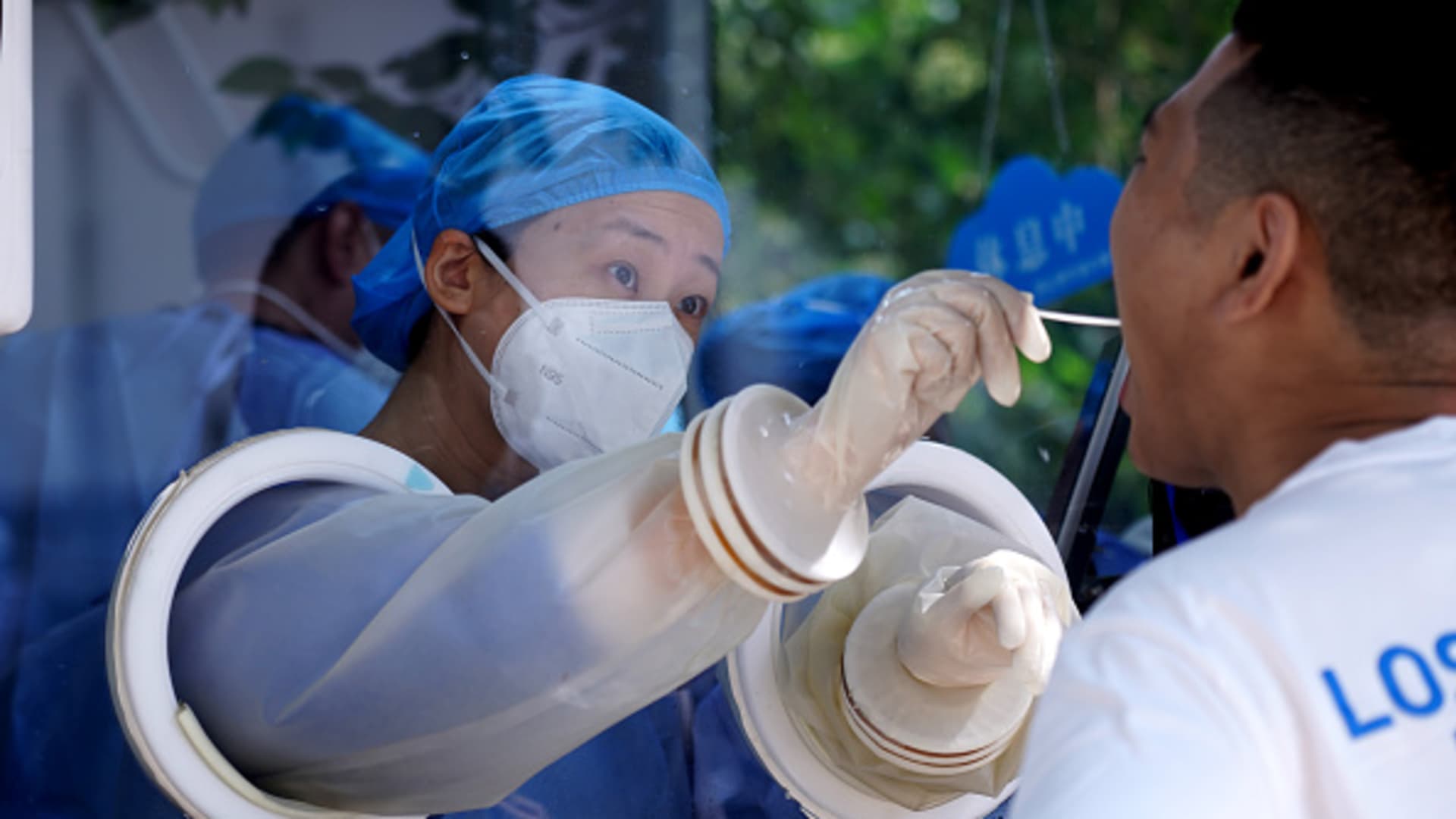
A medical worker in a Covid-19 nucleic acid testing cabin takes swab sample from a resident for Covid-19 nucleic acid test on August 22, 2022 in Zhengzhou, Henan Province of China. It’s been a summer that has seen heat records jump across the globe. China’s health workers have been particularly impacted, enduring relentless heat waves wrapped head-to-toe in protective gear as they continue to test the mass populace for Covid-19, amidst a seemingly never-ending series of outbreaks.
Vcg | Visual China Group | Getty Images
It’s been a summer that has seen heat records jump across the globe.
China’s health workers have been particularly impacted, enduring relentless heat waves wrapped head-to-toe in protective gear as they continue to test the mass populace for Covid-19, amidst a seemingly never-ending series of outbreaks.
Wearing hazmat suits known locally as the “Big White,” the army of workers, responsible for enforcing China’s zero-Covid policy have for a large part of this year been toiling in temperatures of 100 degrees Fahrenheit or more.
“The inner condition is airtight,” Joshua Liu, a health worker from Shanghai told NBC News by telephone last month. “Once the suit is on, we can’t eat, drink and go to the toilet.”
Workers are “soaked in sweat” and their “fingers and palms are wrinkled” when they remove them, said Liu who helped medical staff to collect Covid test samples and register residents’ information.
“I can feel my skin breathing and sweating,” he said. “Every day when I finally get off work, the only thing I want to do is take a shower and fall asleep.”
Use of the “Big White” was brought sharply into the spotlight last month when a video of nurse Chunhua Xie lying on a bed in the emergency room with her limbs twitching went viral on Chinese social media, after it was released by officials in Nanchang County in the eastern Jiangxi province.
Wearing the protective suit, Chunhua had been conducting Covid tests for several days at the People’s Hospital of Nanchang County, when she suffered from heat stroke and fainted, text over the video said. The temperature was just over 100 degrees outside the facility at the time, the video said.
Although she later recovered, the video sparked an online backlash and was later removed by officials.
But by then it had been widely shared and viewed by millions of people on Weibo, China’s largest microblogging site and other social media channels, where some accused the government of incompetence.
A regular sight
The “Big White” has become a regular sight at Covid testing sites as health workers followed guidance on protective clothing issued by China’s National Health Commission in January 2020, shortly after the initial Covid outbreak in the city of Wuhan.
In Shanghai, Liu said he and his colleagues regularly wore the body-covering outfits during Shanghai’s two-month Covid lockdown between March and May, when authorities, pursuing China’s uncompromising “zero Covid” policy, shuttered schools, malls, convenience stores and gyms, and stopped bus, subway and ferry services in the city.
Throughout more localized neighborhood lockdowns in the following months, when residents were barred from leaving and entering their living compounds without a permit, Liu said he and his co-workers helped conduct mass testing and contact tracing, while also helping to enforce strict quarantine requirements.
But as the summer months arrived, temperatures across China began to rise and the mercury regularly hit 100 degrees in Shanghai. So far temperatures of 104 degrees have been hit seven times in the commercial hub of 25 million, surpassing the record of five days hit in 2013.
As a result, heatstroke started to trend on Chinese social media, as people discussed the symptoms which include headaches, vomiting and fever, or in more serious cases people can go into convulsions or a coma.
For Janice Ho, a postdoctoral fellow at the Chinese University of Hong Kong, it was a “good thing” the people were searching for the term because it helped them “be more aware that heat actually has implications for death.”
At the moment the core body temperature hits 100 degrees, “your organs will start failing because it’s too hot to function and your body may stop regulating itself,” added Ho, whose research focuses on heat and public health. “That’s when it becomes fatal. It’s very risky to end up dying from it.”
Several deaths have already been attributed to the searing heat, including that of a 56-year-old construction worker in the city of Xi’an. Admitted to hospital with a body temperature of 109.4 degrees he died from multiple organ failure and severe heat stroke in July, the state-run China Youth Daily reported.
After the video of Chunhua was released, China’s National Medical Center for Infectious Diseases published an article that said that wearing “protective garments (commonly known as the “Big White”) … could greatly increase the risk of heat stroke.” Medical workers were instead advised to wear lighter and more breathable surgical gowns.
But temperatures have continued to soar since then however and on Aug.12 the first “high-temperature red alert” was issued by Chinese National Meteorological Center. That meant four or more provinces recorded temperatures of more than 100 degrees over a 48-hour period and more than 10 provinces were expected to hit between 100 and 108 degrees.
It remained in place for 12 days until Aug. 23.
For Ho, this showed that extreme heat should be taken as seriously as other extreme weather.
“There are drastic measures taken to prevent people from being at risk from typhoons or rainstorms, but we haven’t treated heat in the same way,” she said.







